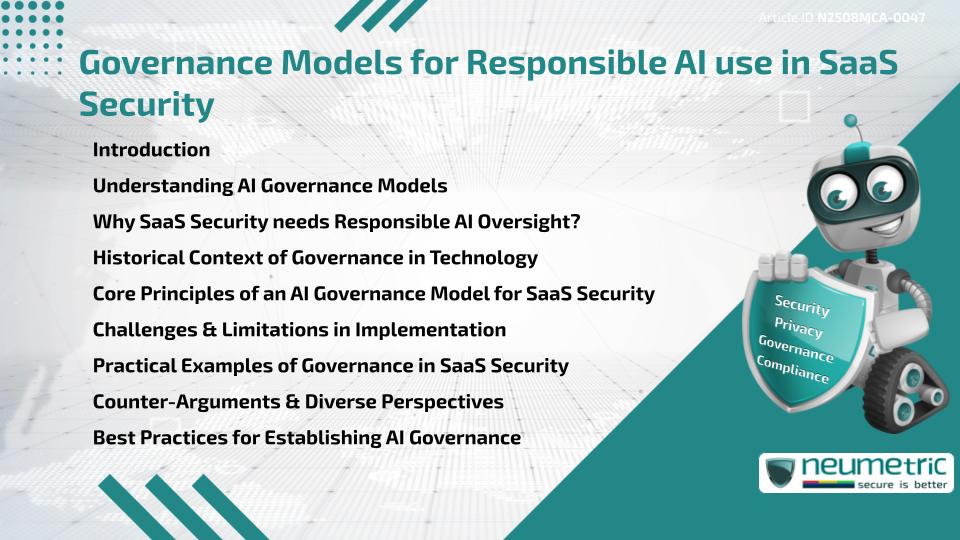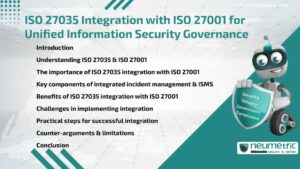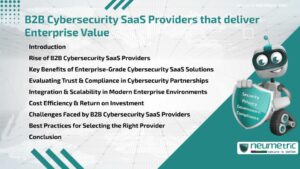Table of Contents
ToggleIntroduction
An AI Governance model for SaaS security ensures that Artificial Intelligence is deployed responsibly, ethically & safely in Software-as-a-Service [SaaS] platforms. Governance involves creating structures, Policies & Controls that regulate AI behavior while aligning with Compliance standards, Data Protection rules & Ethical principles. Without a clear Governance model, AI in SaaS can expose Organisations to Risks such as bias, data misuse, regulatory violations & trust erosion. This article explains how Governance frameworks have developed, why they are crucial in SaaS security & how Organisations can apply Best Practices to maintain responsible AI oversight.
Understanding AI Governance Models
An AI Governance model refers to the rules, Policies & monitoring processes that ensure AI Systems function responsibly. In SaaS security, this Governance balances innovation with Accountability. Unlike traditional IT controls, Governance for AI must address bias detection, explainability, fairness & Continuous Monitoring. Think of it as a “traffic system” for AI-guiding safe usage, preventing misuse & ensuring that all participants understand the rules.
Why SaaS Security needs Responsible AI Oversight?
SaaS platforms rely heavily on automation to detect Threats, manage access & prevent fraud. Without Governance, AI in these platforms may create blind spots or unintended consequences. For example, if an AI-driven access system makes flawed decisions, it could lock out legitimate users or allow unauthorised access. A responsible AI Governance model for SaaS security prevents such outcomes by aligning AI tools with Ethical & Regulatory Standards.
Historical Context of Governance in Technology
Governance in technology has evolved from basic IT Compliance frameworks to sophisticated systems. In the early days, regulations such as ISO 27001 focused on Information Security Management. As AI emerged, existing models proved insufficient because they did not address algorithmic transparency or fairness. The transition to AI Governance reflects the same evolution seen when Cloud Computing introduced new Risks & required SaaS-specific oversight.
Core Principles of an AI Governance Model for SaaS Security
An effective AI Governance model for SaaS security rests on four pillars:
- Accountability: Organisations must assign responsibility for AI decision-making.
- Transparency: AI processes should be explainable & auditable.
- Fairness: AI Systems must avoid biased outcomes that harm users.
- Security & Compliance: Governance should align with Privacy Laws & SaaS Security Best Practices.
Together, these principles create a balanced approach that protects both Organisations & End-users.
Challenges & Limitations in Implementation
Implementing Governance in AI-driven SaaS security is not without challenges. Continuous Monitoring requires technical expertise, while enforcing fairness may be difficult when training data is inherently biased. Governance may also slow innovation if controls become too rigid. Critics argue that strict Governance can reduce the flexibility SaaS Providers need to respond quickly to new Threats. Balancing oversight & agility remains one of the biggest difficulties.
Practical Examples of Governance in SaaS Security
Some SaaS Providers establish AI Ethics Boards to review deployment decisions. Others adopt external frameworks like the NIST AI Risk Management Framework or align with the OECD AI Principles. By doing so, they demonstrate a commitment to Accountability & Transparency. For instance, integrating Audit trails in AI-driven SaaS Security solutions ensures every automated decision can be traced, reducing Compliance Risks.
Counter-Arguments & Diverse Perspectives
Not everyone agrees that formal Governance models are the best approach. Some argue that technical safeguards such as Encryption, Differential Privacy & Robust Testing are more effective than Policies or Ethics Boards. Others worry that Governance frameworks might vary too much across regions, making it difficult for global SaaS companies to comply consistently. Nonetheless, even critics agree that some form of oversight is necessary to avoid harmful consequences of unchecked AI use.
Best Practices for Establishing AI Governance
Organisations can adopt practical measures to implement responsible Governance in SaaS security:
- Conduct bias testing regularly.
- Establish multi-disciplinary oversight committees.
- Maintain clear Audit logs for all AI-driven security actions.
- Align Governance with established standards such as ISO AI Guidelines.
- Provide training to Employees on responsible AI use.
By following these steps, Organisations create a structured AI Governance model for SaaS security that balances innovation with accountability.
Conclusion
AI in SaaS security cannot remain unchecked. Governance models provide the Framework necessary to manage Risks, ensure Compliance & maintain Trust. By focusing on accountability, transparency, fairness & security, Organisations can deploy AI responsibly in SaaS environments.
Takeaways
- Governance ensures responsible AI use in SaaS security.
- Core Principles include accountability, transparency, fairness & Compliance.
- Implementation faces challenges like bias, rigidity & global inconsistency.
- Best Practices include bias testing, ethics boards & aligning with standards.
FAQ
What is an AI Governance model for SaaS security?
It is a Framework of Policies, rules & oversight mechanisms that ensure AI used in SaaS platforms operates responsibly, securely & ethically.
Why is AI Governance important in SaaS?
Governance prevents AI from creating Risks such as bias, security blind spots & regulatory violations in SaaS platforms.
How does AI Governance differ from traditional IT Governance?
Traditional IT Governance focuses on Compliance & infrastructure, while AI Governance addresses bias, fairness, transparency & accountability in algorithmic decisions.
What are the main challenges in AI Governance?
Challenges include monitoring complex AI Systems, managing biased data, balancing Regulation with innovation & ensuring global consistency.
Can Governance slow innovation in SaaS security?
Yes, excessive controls can reduce agility, but well-designed Governance balances oversight with flexibility.
Who is responsible for AI Governance in Organisations?
Responsibility typically lies with cross-functional teams that include Compliance Officers, Data Scientists, Security Experts & Legal Advisors.
Need help for Security, Privacy, Governance & VAPT?
Neumetric provides organisations the necessary help to achieve their Cybersecurity, Compliance, Governance, Privacy, Certifications & Pentesting needs.
Organisations & Businesses, specifically those which provide SaaS & AI Solutions in the Fintech, BFSI & other regulated sectors, usually need a Cybersecurity Partner for meeting & maintaining the ongoing Security & Privacy needs & requirements of their Enterprise Clients & Privacy conscious Customers.
SOC 2, ISO 27001, ISO 42001, NIST, HIPAA, HECVAT, EU GDPR are some of the Frameworks that are served by Fusion – a SaaS, multimodular, multitenant, centralised, automated, Cybersecurity & Compliance Management system.
Neumetric also provides Expert Services for technical security which covers VAPT for Web Applications, APIs, iOS & Android Mobile Apps, Security Testing for AWS & other Cloud Environments & Cloud Infrastructure & other similar scopes.
Reach out to us by Email or filling out the Contact Form…





